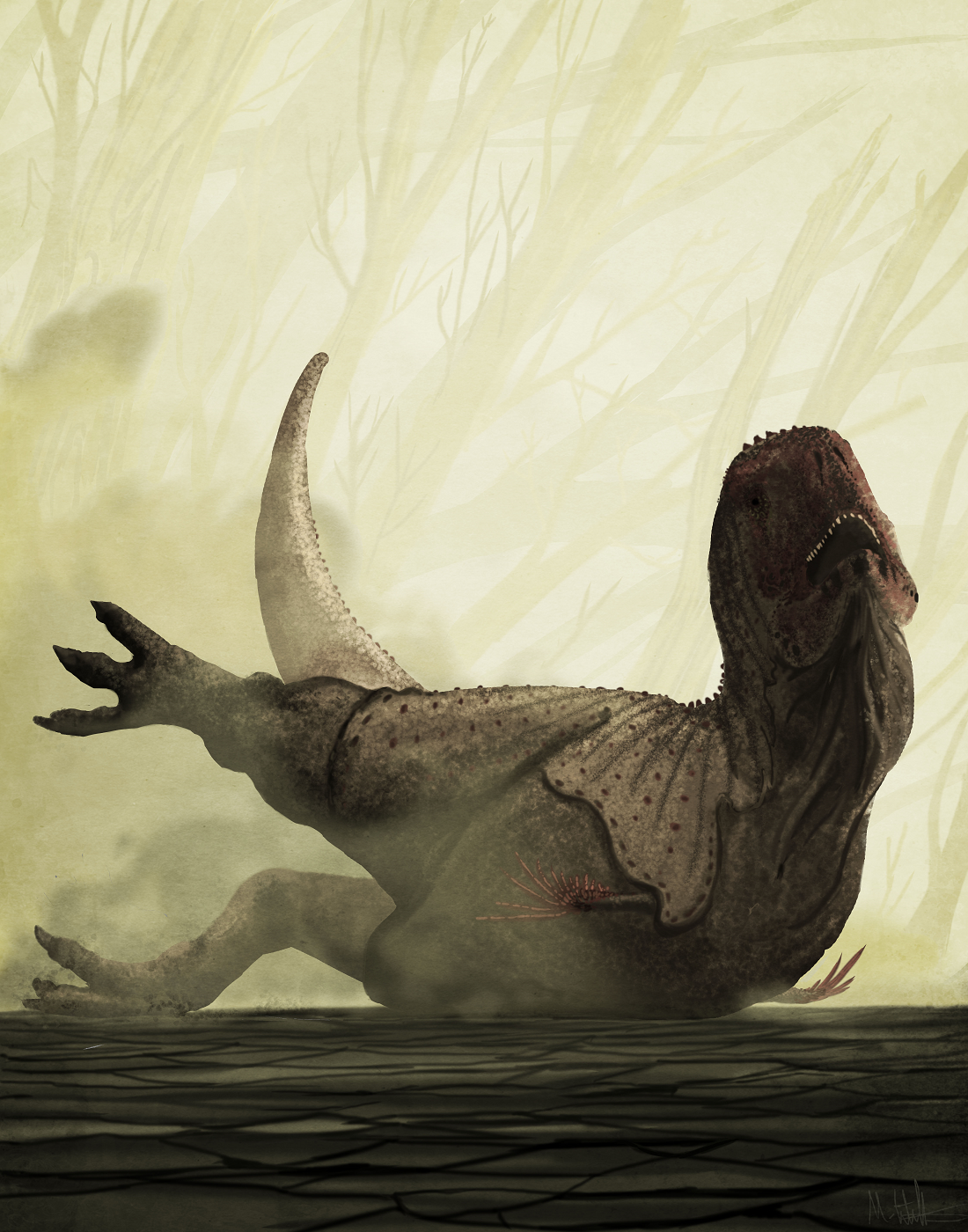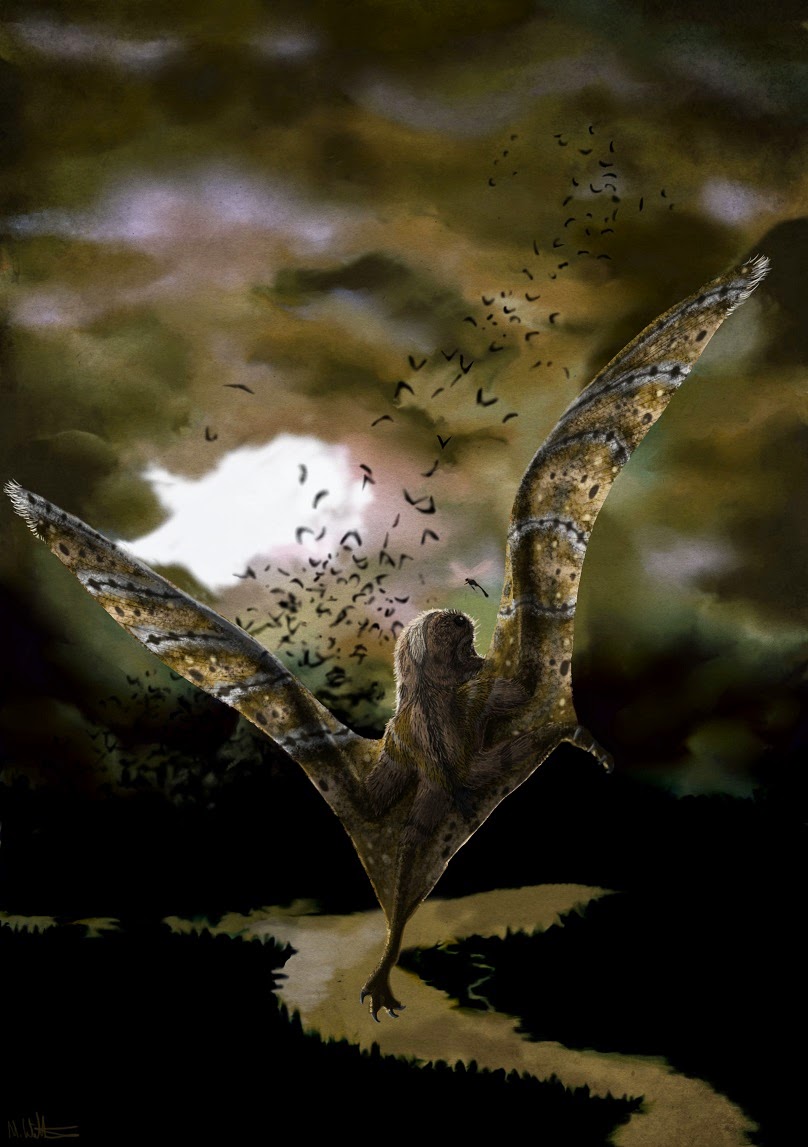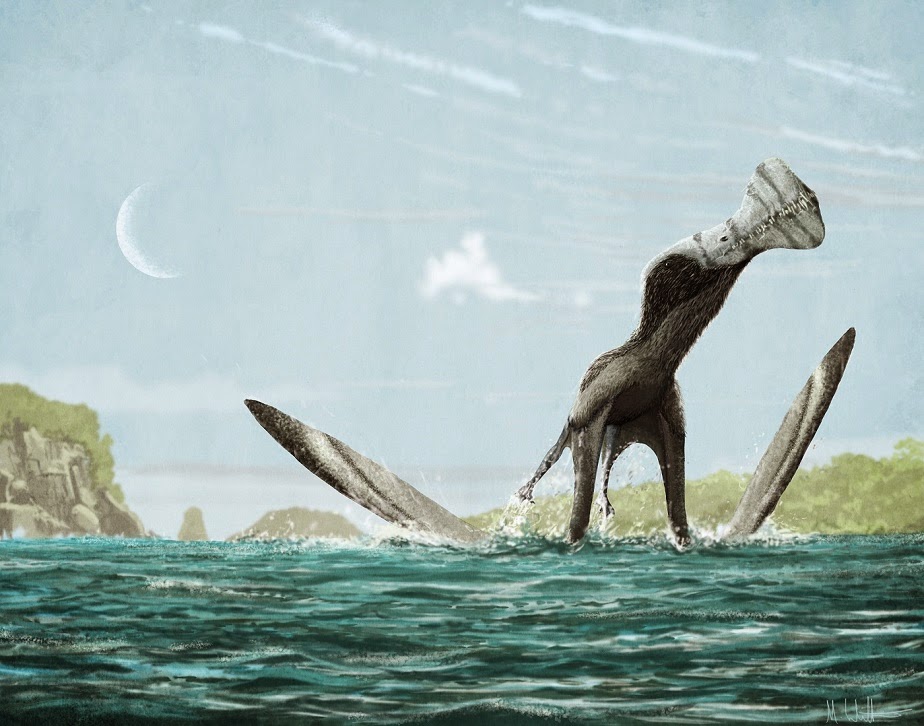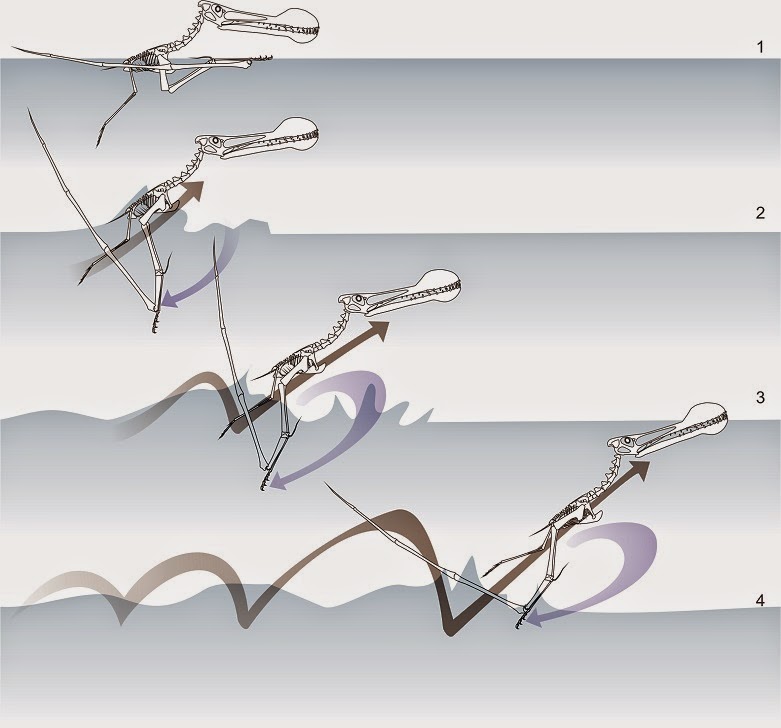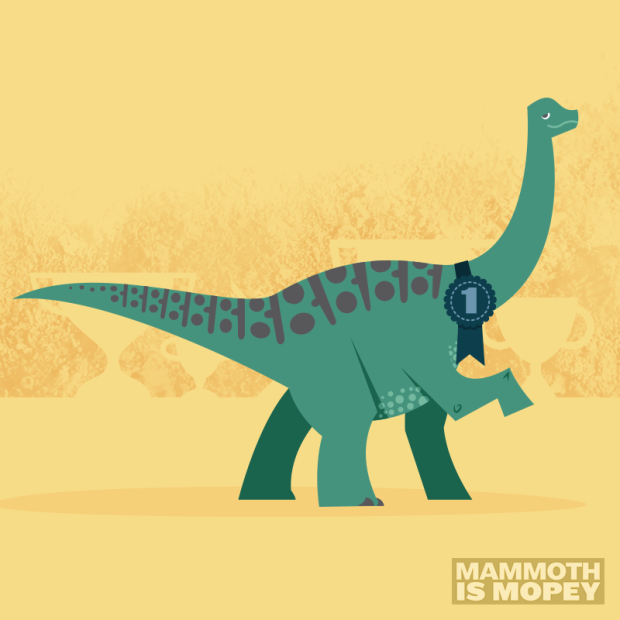![]() |
| Upper Jurassic pterosaur Cuspicephalus scarfi, a species of some uncertain affinity, now confidently restored as a wukongopterid. How come? Read on. If you'd like a print of this image, please head to my print store. |
One of the most significant pterosaur discoveries of recent years are the wukongopterids: small, upper Jurassic pterosaurs unknown before 2009 and most familiar in popular circles for
Darwinopterus modularis. These pterosaurs are renowned for providing a morphological bridge between the two major stages of pterosaur evolution: the loose group of long-tailed species which dominated the Triassic and Jurassic phases of pterosaur history, and the Pterodactyloidea, short-tailed, large-skulled creatures which represent a second, better known phase of pterosaur evolution.
The manner in which wukongopterids link these groups will be familiar to many. Instead of showing a mosaic of basal and derived characteristics as expected from any species slotting into a evolutionary 'gap', their heads and necks developed a anatomies like those of pterodactyloids while their bodies and limbs retained features typical of earlier pterosaurs (Lü et al. 2010). Wukongopteridae is generally considered the sister taxon to the Pterodactlyoidea, the two forming the clade Monofenestrata after their shared attribute of combined nasal and antorbital openings. To date, all wukongopterids have been recovered from the Middle/Late Jurassic Tiaojishan Formation of China and, thanks to many complete specimens, their anatomy is already quite well known. The number of valid wukongopterid species remains uncertain: at least seven have been named, but some authors suggest these are oversplit to such an extent that they should all be synonymised into one species,
D. modularis (Lü et al. 2012). This is yet to be investigated in detail but, if correct, note that wukongopterid posterboy
D. modularis does not have nomenclatural priority. At least one other wukongopterid species was named a few months before
D. modularis; two were if you take the 2010 paper version of the description as the ‘true’ publication date of
D. modularis, not the 2009 online release.
Wukongopterids are not the only pterosaurs shedding light on the origins of the Pterodactyloidea. The recent discovery of another obviously ‘transitional’ taxon, the Late Jurassic, Solnhofen ‘Painten pro-pterodactyloid’ (Tischlinger and Frey 2014), seems to present a step towards pterodactyloid anatomy from that presented by wukongopterids. The only known specimen of this animal, which is privately owned and thus remains nameless, also shows some modularity of evolution with the body and limbs retaining hallmarks of earlier pterosaur evolution, while the skull has developed into something very similar to Jurassic ctenochasmatoids, especially
Pterodactylus antiquus.
![]() |
| Monofenestratan pterosaur skulls. A, the wukongopterid Darwinopterus robustodens; B, likely pterodactyloid sister-taxon the ‘Painten Pro-pterodactyloid’; C, ctenochasmatoid Pterodactylus antiquus; D, azhdarchoid Tupuxuara leonardii; E, early dsungaripteroid Germanodactylus rhamphastinus; F, ornithocheiroid Ornithocheirus mesembrinus; G, early dsungaripteroid Germanodactylus cristatus. Scale bars represent 10 mm, except for D and F, which represent 100 mm. Note that neither A or B are pterodactyloids (the rest are), despite the similar skull shapes. Can we identify their skulls as non-pterodactyloidian without the help of postcranial anatomy? From Witton et al. 2015. |
A crucial question concerning these new monofenestratan pterosaurs is how we recognise them without evidence of their combined ‘early pterosaur’ bodies and ‘pterodactyloid’ heads and necks. All current diagnoses of these pterosaurs rely on this combination of characteristics and, by necessity, need relatively complete specimens for identification. What can be done with fragmentary specimens, the likes of which comprise most pterosaur fossils? At least two teams of authors have suggested that limb proportions of non-pterodactyloid monofenestratans are characteristic so, as long as sufficient limb material is known, their isolated bodies have some chance of being identified. But what about their strikingly pterodactyloid-like skulls? In isolation, these bear so much resemblance to those of Jurassic pterodactyloids like
Germanodactylus and
Pterodactylus (above) that referral outside of Pterodactyloidea is unlikely without an associated, 'early-grade' body.
This is an issue my University of Portsmouth colleagues David Martill, Michael O’Sullivan and I tackled in a
new (open access) paper, published today in
Contributions to Zoology (Witton et al. 2015). Our interest in this problem is not purely theoretical, this paper picking up questions set down three years ago in the description of
Cuspicephalus scarfi, a poorly-known British Jurassic monofenestratan (Martill and Etches 2012). Represented only from a partial skull (below) sharing similarities with both wukongopterids and the pterodactyloid
Germanodactylus,
Cuspicephalus remained of uncertain affinity when first described (Martill and Etches 2012 –
an overview of this paper can be found at Dave Hone’s Archosaur Musings). In the same publication, Martill and Etches remarked that another European Jurassic pterosaur only known from cranial material (jaw tips),
Normannognathus wellnhoferi (below), suffered similar problems to
Cuspicephalus, its once sensible pterodactyloid identification (Buffetaut et al. 1998) now being questionable with wukongopterids on the scene. Taking the Martill and Etches study as our cue, we decided to take a closer look at the characteristics of non-pterodactyloid monofenestratan crania, and apply our findings to these two poorly-known European pterosaurs.
![]() |
| Jurassic pterosaur fossils aren't all complete skeletons and preserved soft-tissues - most of them look like this. A, MJML K1918, holotype skull of the long-snouted pterosaur Cuspicephalus scarfi Martill and Etches, 2013; B, MGCL 59’583, holotype of Normannognathus wellnhoferi Buffetaut et al., 1998. Scale bars represent 50 mm (A) and 10 mm (B). From Witton et al. 2015. |
I don’t want to rehash our anatomical comparisons in full here –
the paper is free for all to read, so you can easily find these details there – but we concluded that yes, wukongopterid skulls are identifiable in isolation - we don't need associated postcrania to identify them. Their skulls are quite generalised in construction and best diagnosed by a combination of 16 character states relating to skull shape, features of the orbit, dentition and cranial crest anatomy, but we also found one character more-or-less unique to the group: an atypically long nasoantorbital fenestra. In exceeding 50% of the jaw length, only two derived Cretaceous pterodactyloid clades (istiodactylids and azhdarchoids) can boast longer nasoantorbital openings than wukongopterids. We also found that the ‘Painten pro-pterodactyloid’ also has its own take on monofenestratan cranial anatomy: like wukongopterids, it is best distinguished via a combination of features, but details of its dentition provide genuine apomorphies.
When applying these findings to our poorly-represented European specimens, we found virtually all evaluable features of
Cuspicephalus (13 of 16) matched those of the wukongopterid character complex, it even bearing that especially long nasoantorbital fenestra. By contrast, it differs from the ‘Painten pro-pterodactyloid’ and ‘generic’-looking pterodactyloids such as
Germanodactylus quite markedly. I’m happy that, as part of our means of demonstrating this, we managed to get some new details of
Germanodactylus cristatus anatomy into the literature. There are specimens of this animal showing really big exoccipital processes (flaring projections anchoring neck muscles at the back of the skull - see illustration, above), but they remain relatively poorly documented. These processes not only have bearings on distinguishing
Germanodactylus from
Cuspicephalus, but might help resolve disputes about the placement of
Germanodactylus among Pterodactyloidea (the relationships of this animal are controversial, but big exoccipitals are only known in dsungaripterid pterosaurs, one of the suggested phylogenetic homes of this taxon). The only feature really distinguishing
Cuspicephalus from wukongopterids are some minor details of its anterior tooth placement, which we see as relatively little concern given strong similarities elsewhere and propensity for dental variation among even closely related pterosaurs. We conclude that the close relationship between
Cuspicephalus and
Darwinopterus suggested by Martill and Etches (2012) is likely, and go further in suggesting
Cuspicephalus is a member of Wukongopteridae itself - the first to occur outside of China.
The picture is not so straightforward for
Normannognathus however. Most of the characters once used to suggest
Normannognathus was related to certain pterodactyloids are now realised as features seen across Monofenestrata, and, in being represented by only jaw tips and one tooth, there's not much to compare with other pterosaurs. A suite of features seen in
Normannognathus (including crest height, upturned jaws, dental characteristics and midline jaw grooves) are found in ctenochasmatoid pterodactyloids, and we tentatively suggest it might have some link to this group. However, without more data, it’s hard to be certain exactly where in Monofenestrata this species belongs. Admitting defeat with
Normannognathus suggests that our abilities to distinguish types of monofenestratan skulls remain a little limited, even after dedicated study – anything less than a near-complete skull (like the
Cuspicepahlus holotype) might prove a challenge to identify.
![]() |
| Cuspicephalus was a relative giant compared to other wukongopterids: that's the second biggest wukongopterid (D. robustodens) on the left. Still, they're not enormous animals overall, as demonstrated by the use of a European robin (Erithacus rubecula) for scale. From Witton et al. 2015. |
Are there any bigger-picture implications to our paper beyond taxonomy? Accepting that this is not a 'game changing' paper, we've at least started adding depth to our understanding of wukongopterid pterosaurs, which I’m happy about. Because these animals were previously only known from a very restricted pocket of space and time (Callovian/Oxfordian strata of China), their identification in Europe allows us to start appreciating the geographic and temporal range this group.
Cuspicepahlus occurs in late-Kimmeridgian stage rocks, inferring that wukongopterids enjoyed at least 5-10 million years of evolutionary history, spread across Jurassic Laurasia.
Moreover,
Cuspicephalus gives us an insight into the disparity of wukongopterids. It is the first wukongopterid with really obvious morphological distinction to previously known Chinese species, which are distinguished by such minor details that, as noted above, their taxonomy has been questioned.
Cuspicephalus possesses a much longer, lower skull than any Chinese wukongopterid, as well as packing in more teeth at the anterior end of its jaws. It’s difficult to say what that means functionally, although we speculate that greater jaw reach and ability to handle small, slippery prey might be related to these features.
Cuspicephalus is also considerably larger than its relatives in China, its skull exceeding 300 mm in length to make it one of the biggest Jurassic pterosaur skulls known. Interestingly, this does not translate into a particularly large animal overall: the heads of wukongopterids are proportionally large, and our wingspan estimate for
Cuspicephalus (based on skull/wingspan ratios in other wukongopterids) is a relatively modest 1.2 m. The largest Jurassic pterosaurs span well over 2 m, so it remains moderately sized at best. However, its wingspan is still a lot larger than any other known wukongopterid however, which can be measured as spanning no more than 884 mm.
We're not quite done with Jurassic pterosaurs here yet: several on-going projects on the functionality of these pterosaurs, some of which are in the publication system, should be emerging in a few months. Hopefully, we won't be waiting long for them...
References
- Lü, J., Unwin, D. M., Jin, X., Liu, Y., & Ji, Q. (2010). Evidence for modular evolution in a long-tailed pterosaur with a pterodactyloid skull. Proceedings of the Royal Society B: Biological Sciences, 277: 383–389.
- Lü, J. C., Unwin, D. M., Zhao, B., Gao, C., & Shen, C. (2012). A new rhamphorhynchid (Pterosauria: Rhamphorhynchidae) from the Middle/Upper Jurassic of Qinglong, Hebei Province, China. Zootaxa, 3158, 1-19.
- Martill, D. M., & Etches, S. (2012). A new monofenestratan pterosaur from the Kimmeridge Clay Formation (Kimmeridgian, Upper Jurassic) of Dorset, England. Acta Palaeontologica Polonica, 58(2), 285-294.
- Tischlinger, H. & Frey, E. 2014. Ein neuer Pterosaurier mit Mosaikmerkmalen basaler und pterodactyoider Pterosaurier aus dem Ober-Kimmeridgium von Painen (Oberpfalz, Deutschland) [A new pterosaur with moasic characters of basal and pterodactyloid Pterosauria from the Upper Kimmeridgian of Painten (Upper Palatinate, Germany)]. Archaeopteryx 31, 1-13.
- Witton, M. P., O’Sullivan M., & Martill, D. M. 2015. The relationships of Cuspicephalus scarfi Martill and Etches, 2013 and Normannognathus wellnhoferi Buffetaut et al., 1998 to other monofenestratan pterosaurs. Contributions to Zoology, 84(2), 115-127.







